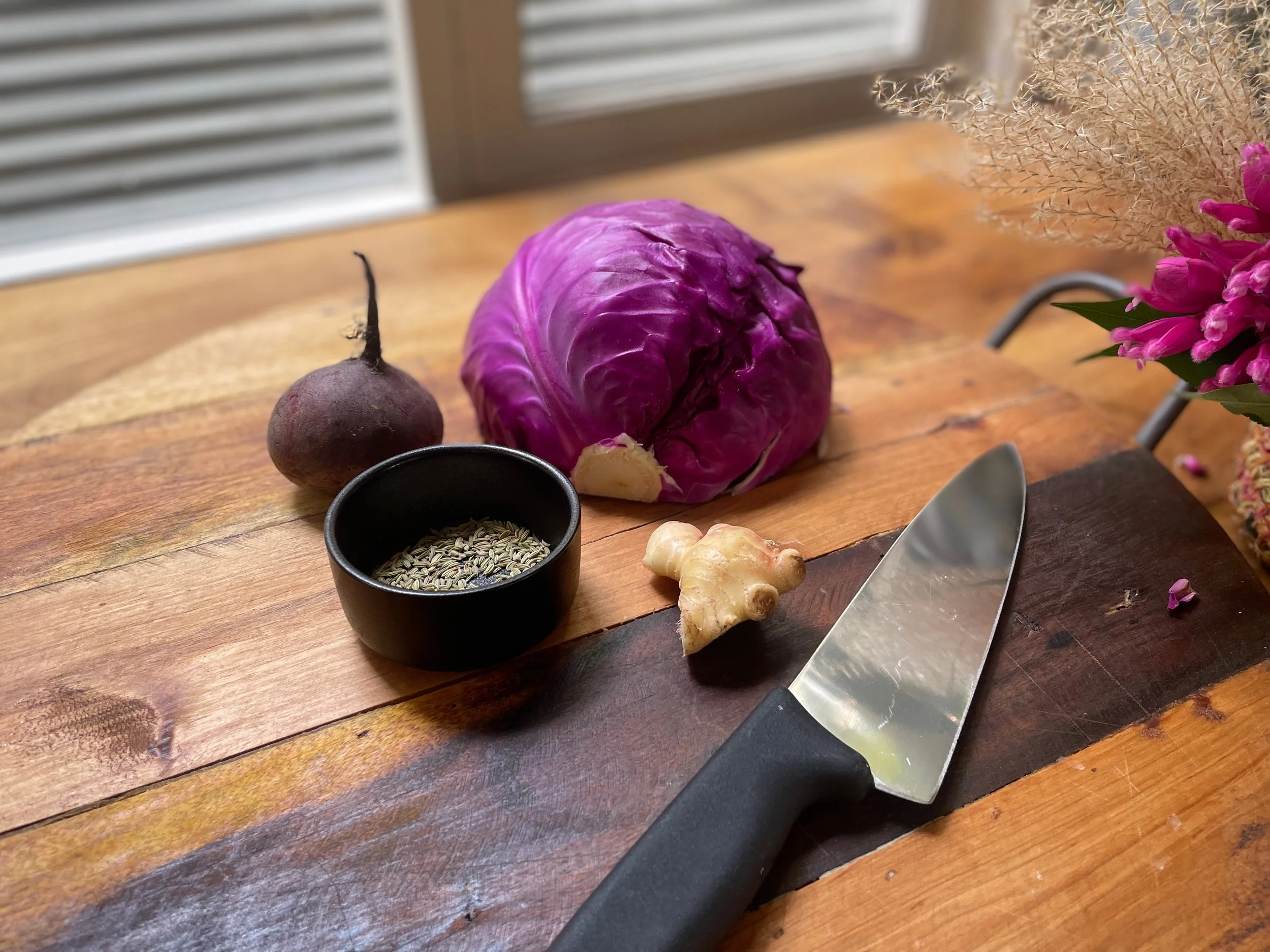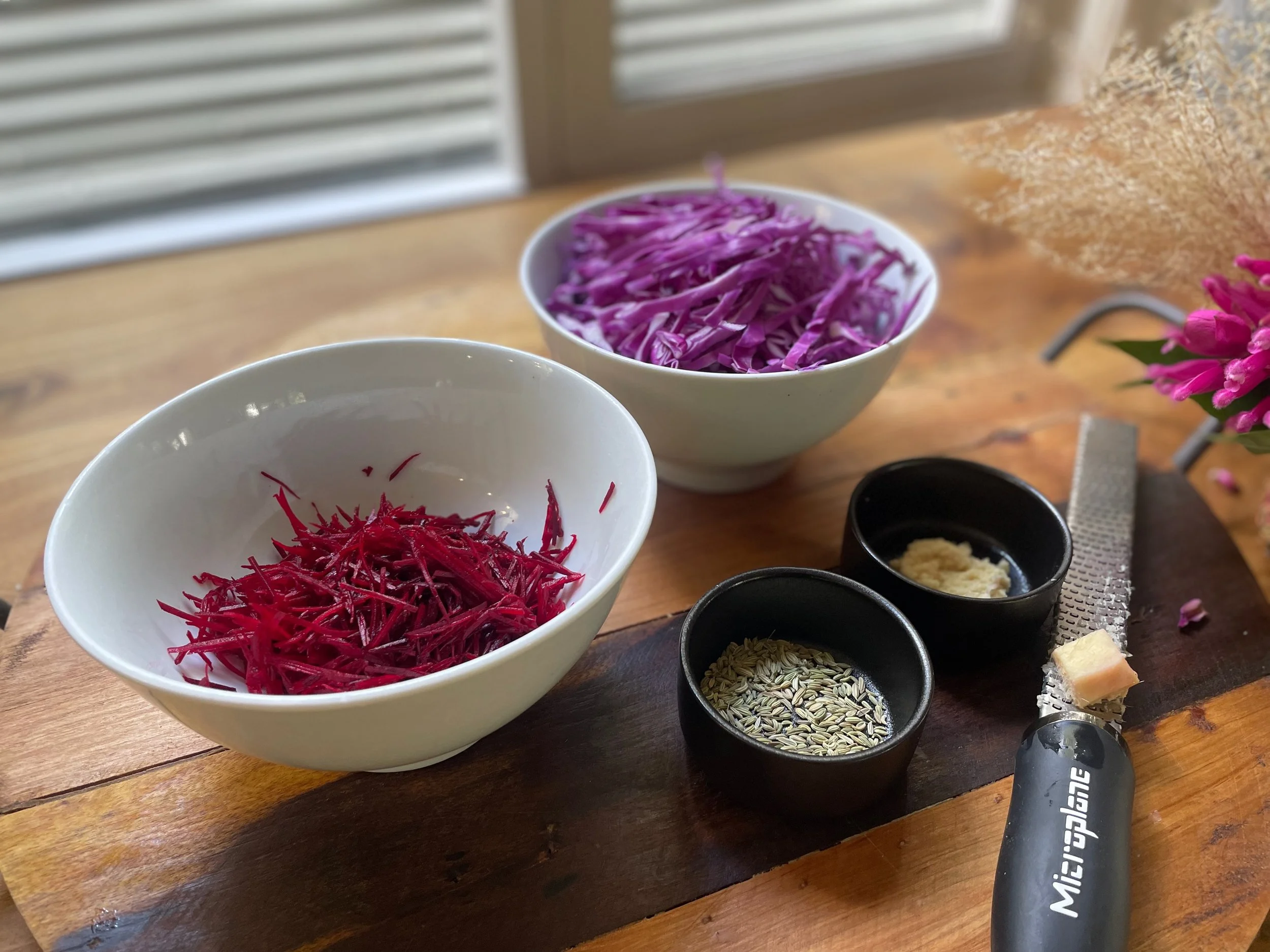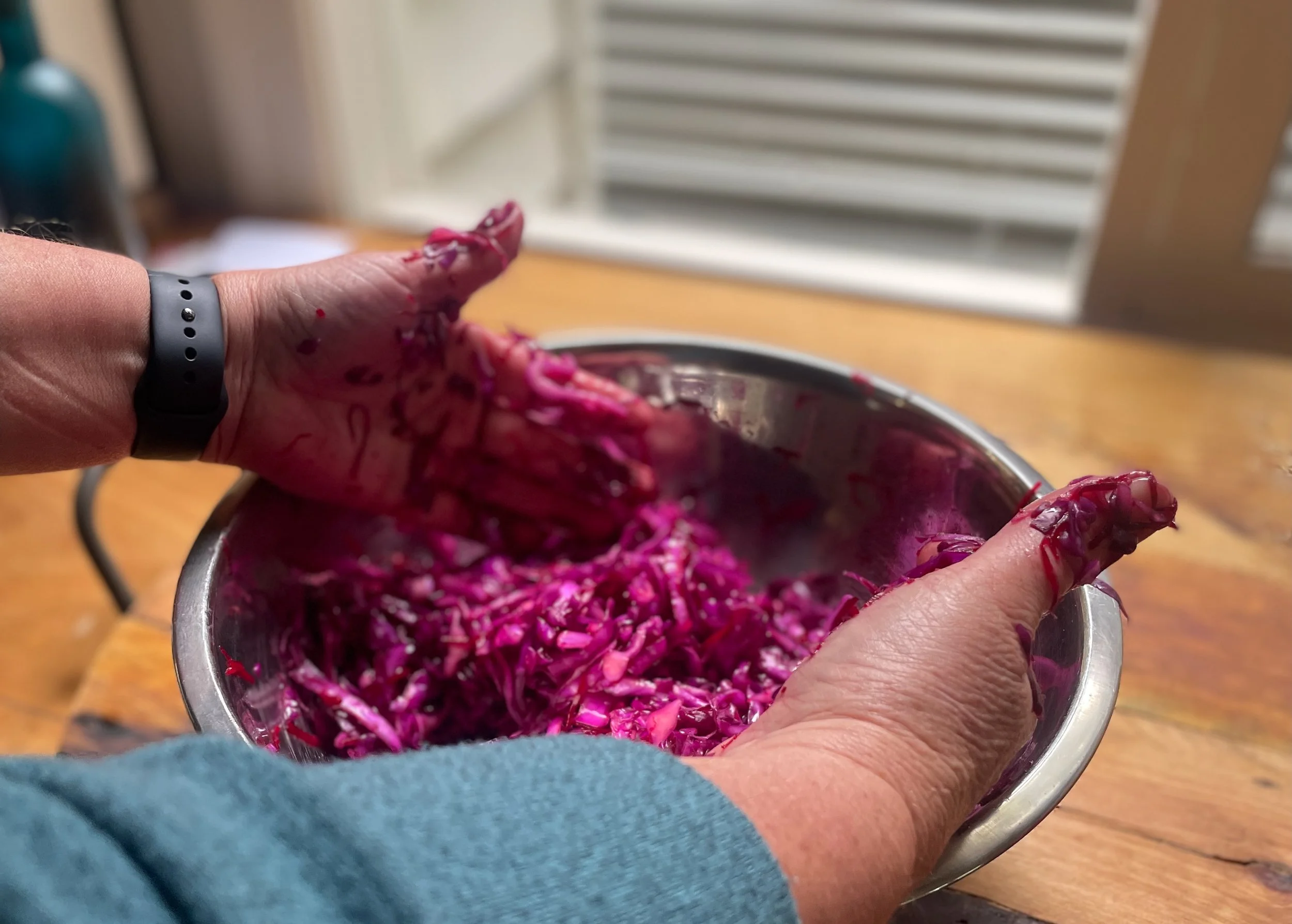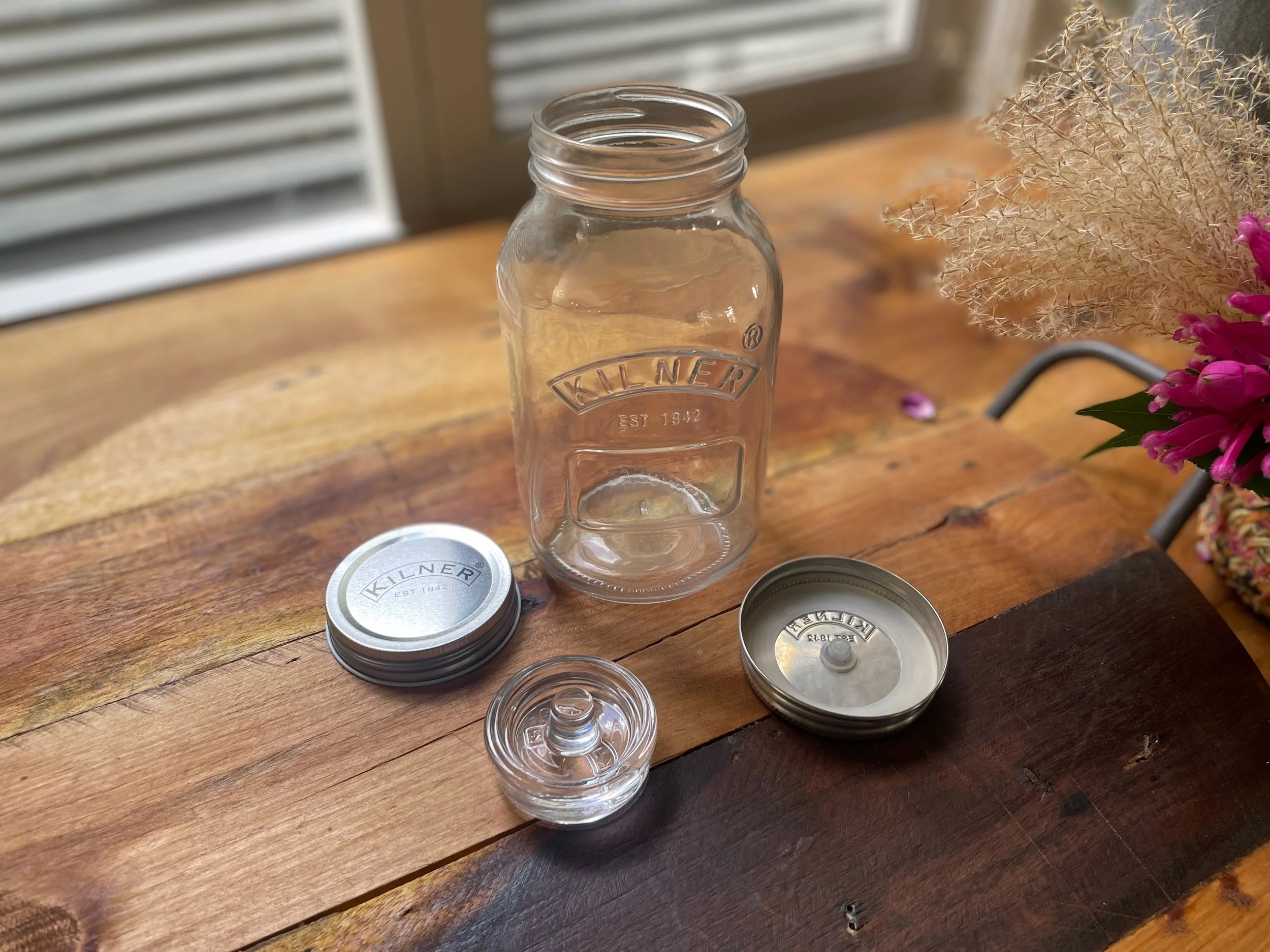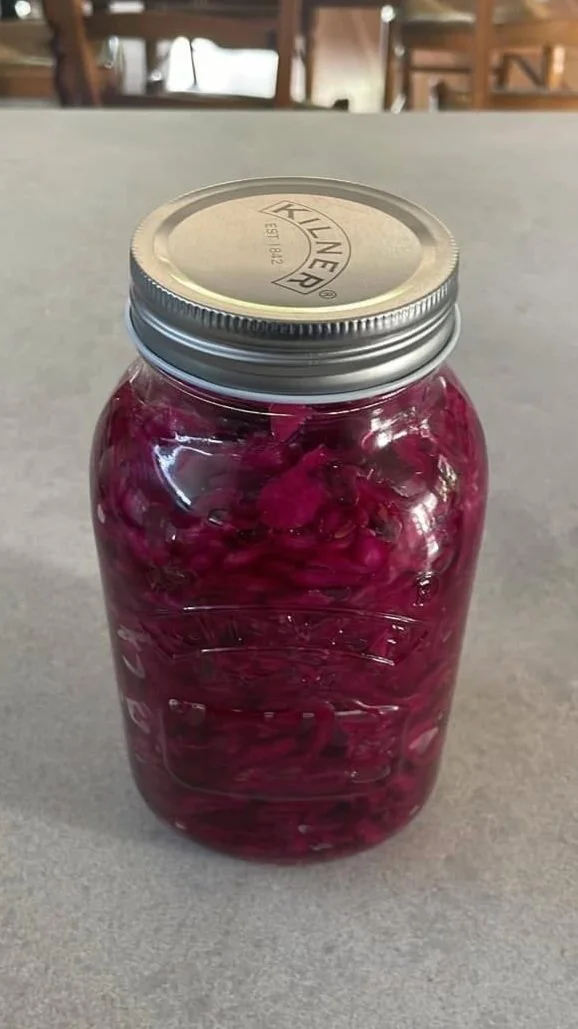Red cabbage, beetroot and fennel sauerkraut
The ruby red goodness of my very own red cabbage, beetroot and fennel sauerkraut
I’ve never had much to do with sauerkraut. When I lived in France a million years ago, I’d somehow managed to avoid choucroute garnis, a hearty Alsatian delicacy, which pairs massive quantities of sauerkraut with many, many pork products. I don’t mind cabbage, but rarely cook with it, so I approached the idea of making my own sauerkraut with some trepidation.
After being convinced by multiple podcasts and articles about the benefits of sauerkraut for gut health, I bit the bullet and bought some from my local fancy food store. It’s hard to describe the taste. It’s sour, salty and a little bit funky, and while I don’t like eating it on its own, it is a good addition to salads. So far so good, but $15 per jar seemed a lot to pay for some tangy cabbage – even for the pretty red one that I favoured – there’s something deeply uninspiring about kraut made with green cabbage (although I'm sure it tastes much the same).
First, take your cabbage
The raw ingredients: red cabbage, beetroot, ginger and fennel seeds.
As I set off on my fermentation journey, I clearly need a guide. I found a book called Fermenting: A fully illustrated guide to good gut health, which boasts 65 fully illustrated recipes for a range of fermented delights from kimchi to kefir (milk and water) to kombucha, working its way up to my lockdown nemesis – the sourdough starter. I should explain: when the world went wild for baking sourdough I thought I’d give it a go. It’s not clear where I went wrong, but after about four days it turned black and developed a smell strongly reminiscent of dirty socks. I never tried again.
As it happens, Fermenting doesn’t contain the recipe for sauerkraut that I wanted to make (see previous comment about green sauerkraut). The fancy sauerkraut I’d been buying had red cabbage and beetroot and I wanted to make that one. So, I searched online and found a couple of different versions that kind of met my brief. After a couple of goes, I realised that it’s science, and as such, there is a formula. All I needed to do was to understand the proportions of different ingredients and the overall process and I was good to go.
Step 1: Chopping
Making sauerkraut is pretty simple. Once you have your quantities sorted, it’s a matter of chopping or grating your ingredients before you get started. Grate the beetroot, which is a pretty messy business – English cookery writer, the late Jane Grigson famously described beetroot as a ‘bossy vegetable’ because it stains everything it touches. Chop the cabbage, trying to keep it all about the same thickness. Finely grate some ginger, and you are good to go.
Step 2: Salting
Next, we combine the cabbage and beetroot with salt. This is where the science comes in. Salt is the ingredient that draws out the juices from the vegetables, creating a brine with the right environment for the sauerkraut to ferment in. Salt inhibits the growth of nasty bacteria and promotes the growth of good bacteria. You will need to calculate the amount of salt you need based on the weight of your chopped vegetables. You need to have a 2% concentration of salt, so if you have 800g of cabbage and beetroot, you will need to add 16g of salt.
Step 3: Massage time
Here’s where things get messy. The ultimate aim of this step is to encourage the production of enough brine to cover the sauerkraut in the jar. To do this you need to get your hands dirty (while keeping everything very, very clean). Massage the salt into the cabbage and beetroot mixture for a good five to ten minutes. The longer you massage, the more brine you will produce. I did this batch for almost ten minutes, and it is the best one I’ve made so far.
Once that’s done, add the fennel seeds and grated ginger and mix it through and you are ready for the next step…
Step 4: Bottle it up
You can use any jar, but these Kilner jars come with lid options for different stages of the process and a glass weight.
A word about jars. You’ll need one to put your kraut in. I use these Kilner jars, which are 1L jars that come with different lid options and a glass weight.
Pack the sauerkraut firmly into the jar, and top with the glass weight to keep the sauerkraut submerged in the brine. Some recipes recommend topping with a piece of cabbage leaf, but I’ve found this has the potential to go a bit funny looking (a technical term I believe), so I mostly don’t bother.
If you have these jars, use the lid with the silicone seal and valve and pop your sauerkraut in a dark cupboard for three weeks (although you can do it for up to six weeks apparently), checking every couple of days. If you don’t have one of these lids, you’ll need to be more diligent with the checking – after a couple of days the kraut starts to fizz, so you will need to release any built up pressure by opening the lid every few days. With the Kilner lids, any overflow from the fizz will be released in the form of a weird brown foam via the valve. You’ll have to take my word for that though – I forgot to take a picture when it happened to me.
The finished product
Ta-da! Doesn’t that just scream good health?
Once you’re happy with the tanginess of your sauerkraut, take out the weight, swap to a solid lid and pop it in the fridge where it will keep for up to six months.
One more thing…
If you’re wondering about what to do with your sauerkraut, here are two of my favourite serving suggestions:
Add a large spoonful to a big salad after you’ve dressed it. It adds a nice crunch and tang.
Spread avocado on a piece of wholemeal toast, add a spoonful of sauerkraut and top with an egg. Extra points for adding some seeds of some sort. Delicious!
Serving suggestion 😊
Red cabbage, beetroot and fennel sauerkraut
Makes roughly 1L
Ingredients
750g red cabbage, shredded
1 medium beetroot, grated
3cm piece of ginger, peeled and finely grated
1 tablespoon fennel seeds
Salt (2%)
Method
Discard the outer leaves of your cabbage before washing well and uniformly shredding it. Peel and grate the beetroot. Weigh the cabbage and beetroot together to calculate the amount of salt you will need to add – you will need 2g for every 100g of vegetable.
Add the salt to the vegetables and massage the mixture firmly for five to ten minutes. At the end of this time your mixture should have produced a generous amount of brine.
Add the fennel seeds and ginger and combine well.
Transfer the sauerkraut mixture and brine to a clean 1L jar, pressing the mixture in well as you go. Pour any remaining brine on top and press down the sauerkraut so that the brine covers it. If you don’t have enough brine, you can make a 2% saline (1/2 tsp salt in 1/2 cup water) mixture to top up your jar. Weigh down the sauerkraut with a preserving weight or a cabbage leaf and seal the jar.
Place the jar in a cupboard for three to six weeks (I do three), checking every few days to relieve any pressure build up from the fermentation process. Once the sauerkraut is done to your taste, remove the weight and seal the jar before refrigerating.


